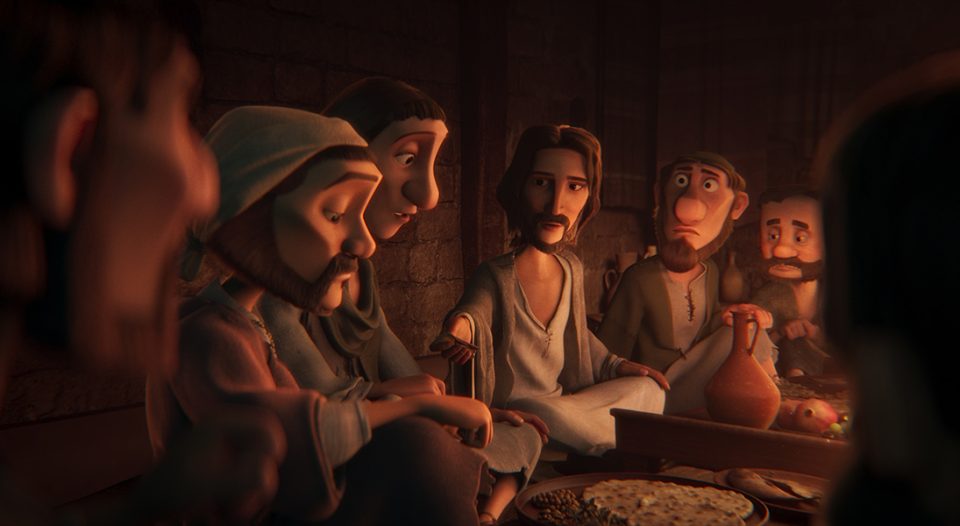“I don’t want to hear about Jesus,” declares a precocious little boy, wielding a toy sword and dashing around his tired father’s office. “I want to hear about King Arthur!”
That statement comes from young Walter, one of the main characters of The King of Kings, a new animated retelling of the Gospel stories. But it might also echo the feelings of some kids in the audience when they learn that they’re going to see a movie about Jesus instead of A Minecraft Movie or the latest Marvel entry.
To its credit, The King of Kings understands its audience’s reluctance and compensates with high-end talent. The first animated feature by media company Angel Studios, The King of Kings has put big money into the production, drawing Hollywood names such as Kenneth Branagh, Oscar Isaac and Pierce Brosnan. Writer-director Seong-ho Jang, who makes his directorial debut here, also has a significant cinematic pedigree, having worked on well-regarded South Korean movies such as Joint Security Project and Save the Green Planet!
The result is a project that feels professional—better than what you’d see streaming on Netflix at any given time, but far less than the offerings at Disney or Pixar. The actors all give credible performances, especially the wonderfully hammy Branagh and the reliable Mark Hamill. But the character designs have a grotesqueness that turns distracting, especially when presented in disconcertingly smooth and untextured animation.
However, The King of Kings overcomes its technical shortcomings thanks to its inspiration, the lesser-known Charles Dickens book The Life of Our Lord, which he told to his children every Christmas.
Using The Life of Our Lord as a template gives The King of Kings a surprising freshness. The film opens with Dickens (Branagh) onstage, performing A Christmas Carol, when his precocious son Walter (Roman Griffin Davis) interrupts, waving his sword and chasing his cat. The antics annoy Dickens, who plans to punish the boy when they get home. Instead, encouraged by his wife (Uma Thurman), he decides to tell the boy something exciting instead.
Using The Life of Our Lord as a template gives The King of Kings a surprising freshness.
Thus, The King of Kings presents its Gospel story through the perspective of Dickens and Walter, who seem to interact with Jesus (Isaac) and other characters. The injection of a child character allows the movie to play the material more or less straight, as described in the Gospels, while Walter guides the reactions or, when necessary, breaks the tension with a comic set piece.
That’s particularly helpful when The King of Kings portrays upsetting parts of Jesus’ story, such as the slaughter of the innocents and his crucifixion. In these instances, Dickens arrives onscreen to describe these events with a mixture of frankness and hope, reminding Walter and kids in the audience of Jesus’ promises.
That focus on hope amid darkness stands out particularly when Dickens and Walter compare Jesus to other kings. Where King Arthur, as Walter often points out, saves the day by shining his sword, and Herod (Hamill) or Pilate (Bronson) have their soldiers and legionnaires, Jesus has his kindness, empathy and sacrifice. With every bit of bleakness comes a reminder that Jesus has overcome the world and its violent ways.
The reminder comes not just for Walter but for many Christians today as well. In her 2024 Easter message, ELCA Presiding Bishop Elizabeth Eaton compared the fear that seized the disciples when they saw the empty tomb in the Gospel of Mark to the fear we feel today in uncertain times. Eaton urged the church to find a way out of this fear by being amazed by Jesus’ victory over death.
Eaton wrote: “When things seem to be staying the same, when things seem to be happening and coming at us so quickly, I think it’s very important to take time to be a little amazed, to be standing in a different place, to have a sense of this awe and trembling before the Lord, and to allow ourselves to be possessed by the Spirit, who will give us power and courage in these times.”
Such a message resonates not only with children, who may get scared by the violence in the Easter story, but also with audience members of any age who may be used to—and even longing for, particularly in volatile times—typical hero characters who conquer villains through traditional power.
Those desires are echoed every time Walter calls for Jesus to take up a sword and fight his enemies. But The King of Kings redirects those sentiments by showing that Jesus overcomes the world through his death and resurrection, replacing a fear-based call to action with an amazement for the Prince of Peace.






